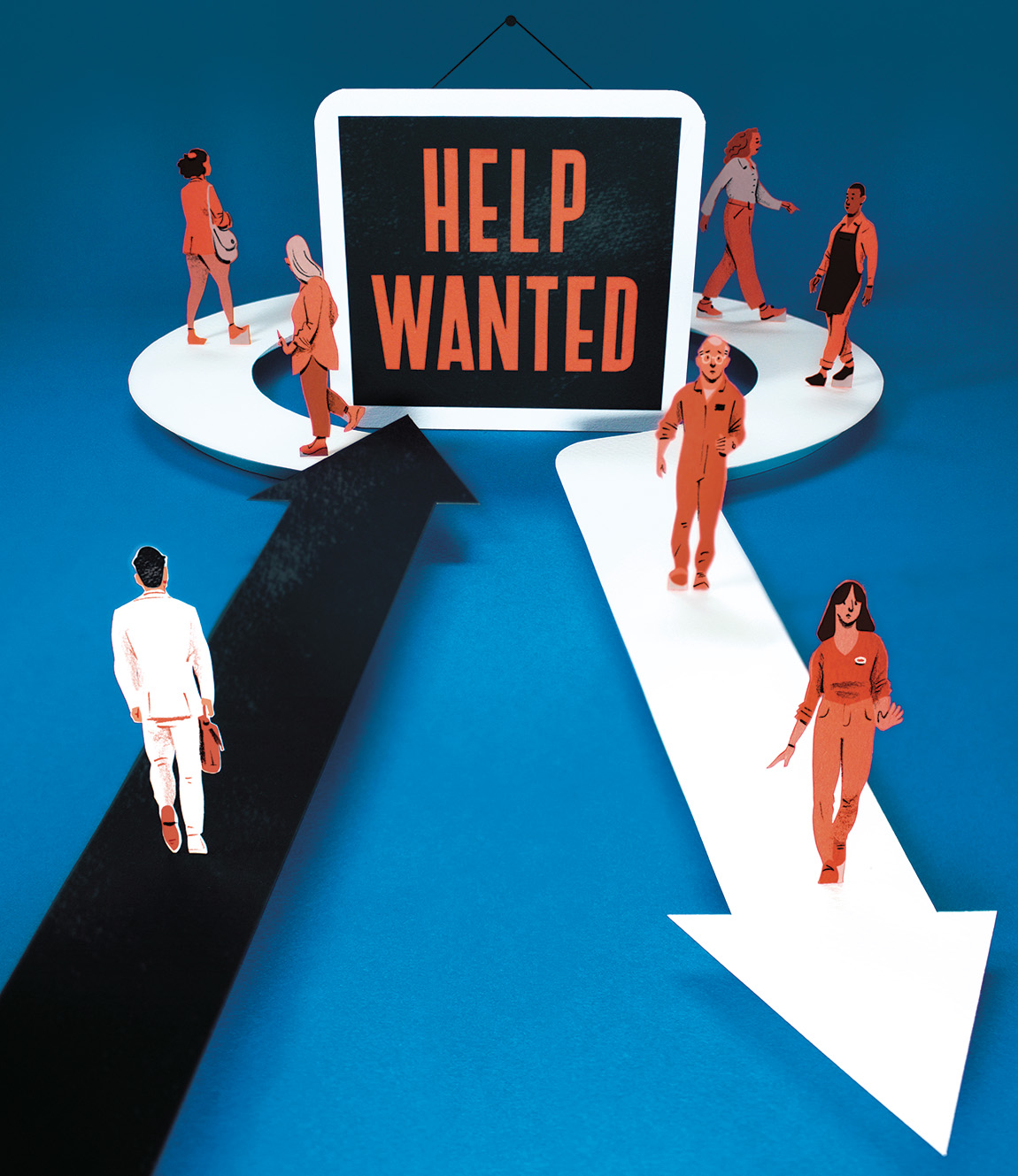Now Hiring
The current labor shortage could end in a way that strengthens the economy if employers would provide better pay, benefits and training for their workers.By: Yariv Fadlon Wednesday, November 10, 2021 02:58 PM
 Illustration by Jeff Hinchee
Illustration by Jeff HincheePerspective is a feature of Muhlenberg Magazine. This article originally ran in the Fall 2021 issue.
Throughout this year, many employers have struggled to find workers. The Bureau of Labor Statistics reported that by the end of July 2021, the number of job openings in the United States increased to a new high of 10.9 million. The number of people who were unemployed that month was about 8.7 million. Thus, even if all unemployed workers would fill the currently available jobs, there would still be a labor shortage. At the same time, the U.S. economy is booming after recovering from the intense slowdown in the second quarter of 2020 due to the start of the pandemic.
The fast economic recovery in the last year has increased the number of low-skilled jobs in many industries, especially retail, hospitality, food services and construction, but the supply of low-skilled workers has been much smaller. The supply-and-demand model would predict an increase in wages to close that gap. While the wage per hour did increase in many low-skilled jobs (by 12.45 percent over the last year for hospitality jobs, for example), so did the number of job openings (by 70 percent, for hospitality jobs).
So where are the workers? Many employers cite the fear some Americans have of being infected with the virus as one cause of the shortage, especially because many of these low-skilled jobs require constant interaction with other people. Meanwhile, the federal government and many state governments increased the duration and amount of unemployment benefits at the start of the pandemic. Many workers were making more through unemployment than they did from their pre-pandemic jobs.
In an attempt to combat the worker shortage, the federal government and many state governments have removed the unemployment benefit extension and increase, which reduced the unemployment benefits to millions of Americans. The idea was to lower the incentive for unemployed workers to stay at home. Whether these changes reduce the worker shortage is yet to be seen, but they most likely will not. The economic literature does find evidence that unemployment benefits discourage workers from seeking jobs, but that effect is found to be small. In addition, 25 states eliminated the generous unemployment benefits at the beginning of the summer and continued to experience a labor shortage.
What else might explain the labor shortage? In the last three decades, many middle-skilled jobs vanished from the U.S. labor market. (To give one example, in the past, financial services representatives did not need a college degree, and a lot of what they did—calculating loan payments or expected retirement balances—is now done by computers.) In addition, the majority of the jobs that were created in that 30-year period were either low- or high-skilled jobs. This, in turn, has increased the inequality within the labor market.
One possible reason for the labor shortage might be that for low- and middle-skilled workers, the motivation to work for low wages declined during the pandemic. Since the generous unemployment benefits have ended, many low- and middle-skilled workers will have to either accept a low-paying job or adjust to a lower income.
But the return of some of these workers to low-paying jobs is not likely to close the shortage, because the supply might not be as large as before the pandemic. Families with young kids might transition to relying on one parent working while the other parent watches the children. Young adults who used to hold two or even three low-skilled jobs might switch to one job. If these are the main driving reasons for the labor shortage, then the problem is with the lack of good job opportunities. (It’s also possible that death and disability from COVID-19, including from “long COVID,” is affecting the labor pool, but that’s beyond my area of expertise.)
The current labor shortage, then, could be an opportunity to alleviate some of the inequality in the labor market and even to boost economic growth. The average income of the poorest 20 percent of households in the United States has remained stagnant at a non-livable level for decades. When poor households earn so little, those individuals lack the means to learn a new skill or attend college. This, in turn, lowers the U.S. economic growth rate. An economy is also much healthier without the huge inequality in incomes and job opportunities that characterizes the U.S. economy.
If employers increased wages and benefits to low-skilled workers and trained them to be more productive, prices would remain stable. And, one well-trained, better-paid worker could handle the same amount of responsibility as a few of the untrained, low-paid workers employers are currently trying (and failing) to find, reducing the number of job openings we see today.
Yariv Fadlon is an assistant professor of economics at Muhlenberg.
